How to Get Rid Of Coyotes
35 min read Updated for March, 2019
Historically, coyotes were found living in the deserts and plains regions of Mexico and the Western United States. Over the past century, the species has increased and spread, inhabiting nearly every region of the U.S.. They can thrive anywhere —from forests and grasslands to cities and suburban backyards.
Their ability to live almost anywhere is a result of their adaptability, intelligence, and fast rate of reproduction. Coyotes can survive in a broad range of habitats because they are opportunistic feeders who eat a wide range of foods from lizards, rodents, rabbits, and deer to domestic pets and garbage. They are classified as a pest species because of the destruction that can come about as a result of their scavenging behavior. Although they are generally timid around humans, there are instances where they pose a serious threat to pets and children.
Here is what you need to know if you find yourself wondering how to deal with a coyote that has gotten too close for comfort.
35 min read Updated for March, 2019
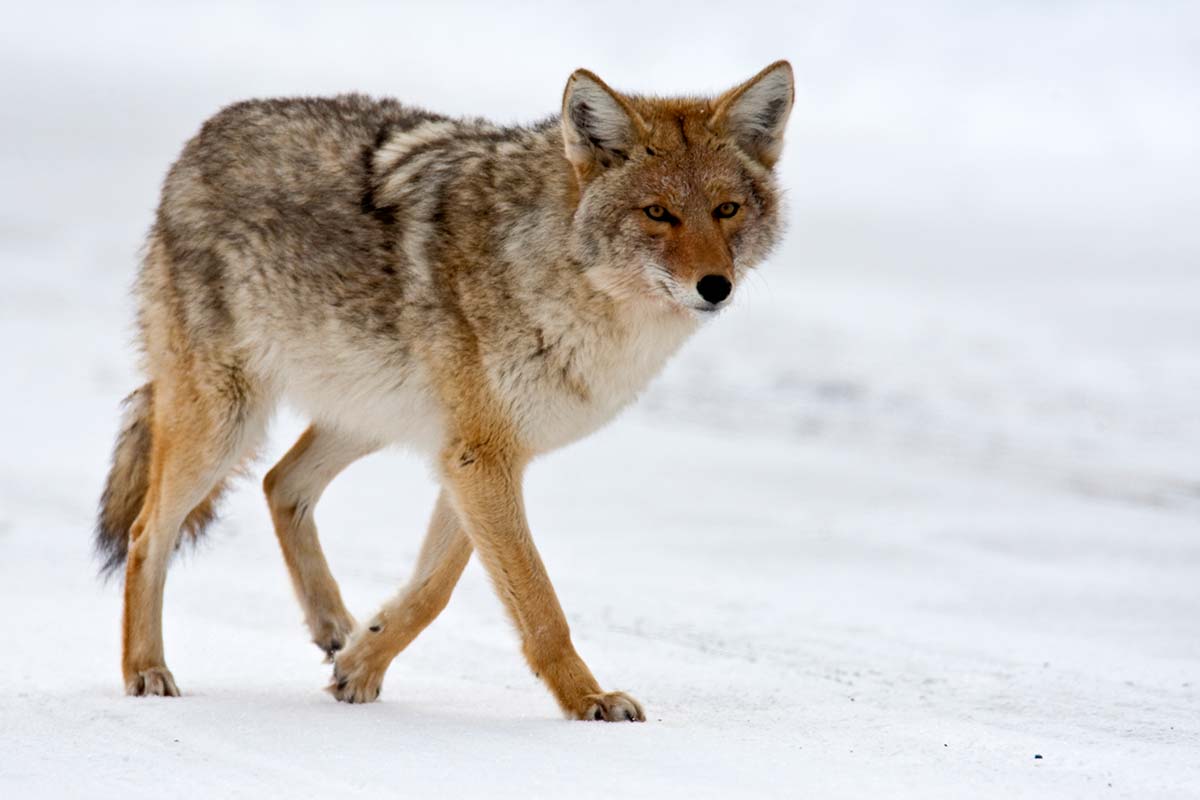
Coyote Sounds
As with any canine, coyotes will bark, growl, snarl, and howl. Make sure you keep pets indoors to avoid any danger.
Coyote Tracks
As a canine, coyotes have four paws with four toes (claws) with the outer toes slightly larger. Their hind tracks are slightly smaller than the front. Their prints are oval shaped, approximately two and a half inches long by two inches wide. A coyotes gait will vary from walking and trotting to jogging and a full out run. They typical, and favored trot, will have the front and hind feet land close together with the hind feet landing slightly ahead of the front. This kind of gait often measures from 15 and 22 inches.
Coyote Poop
Coyote poop is often rope-like and spongy, two inches long and a half an inch in diameter, segmented and tapered. It usually contains hair and bone (although sometimes grass and berries), and is often gray colored.
Identify
Physical Characteristics of a Coyote
Coyotes are members of the Canidae family, which means that they are related to wolves, dogs, foxes, and jackals. In appearance, they look like scrawny, feral German Shepherds, though they are quite a bit smaller weighing an average of 25 pounds. While they are closely related, coyotes have quite a few characteristics that distinguish them from dogs and wolves:
Coyote Appearance
- Large, pointed ears
- Slender body
- Long, tapered snout
- Long, bushy tail that they carry low to the ground
- Yellow eyes
- Thin legs with small feet
- Gray, tan, white, or brown fur depending on where they live
- Males are larger than females
- 48-60 inches long from head to tail
- 20-50 pounds
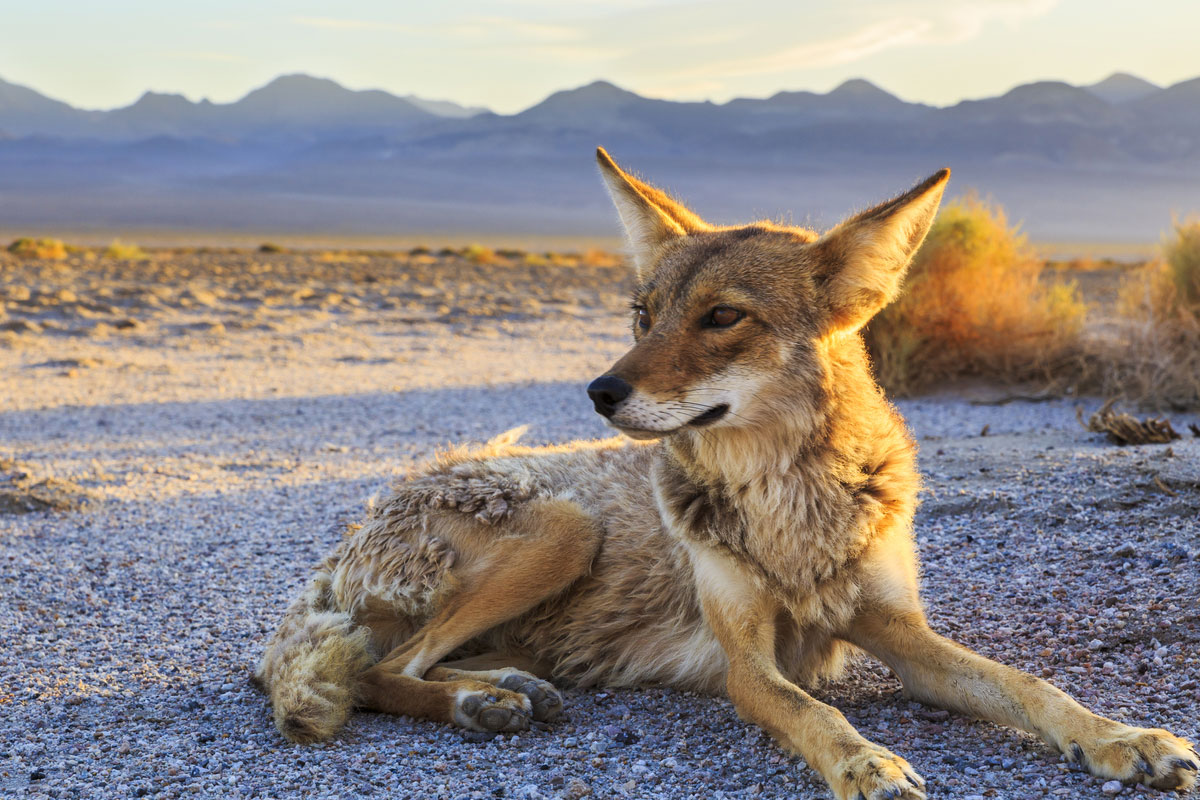
Common Species of Coyotes
From Northern Canada to Central America, there about 19 subspecies of coyotes. Those 19 subspecies divide into four general categories based on their locations. There is very little, if anything, that physically distinguishes one type from the next besides slight color and size variations. Here are the four main types of coyotes:
Central U.S. Coyotes
This group lives in the central states region and includes the following four subspecies:
- The Plains Coyote
- The Texas Plains Coyote
- The Mearns’ Coyote
- The Lower Rio Grande Coyote
Eastern Coyotes
They are found in Eastern North America and include the following two subspecies:
- The Northeastern Coyote
- The Southeastern Coyote
Treating Your Property For Coyotes
While exclusion methods that employ fences and barriers offer the most effective long-term protection, coyotes are intelligent and with enough determination (or hunger), will find a way to conquer most fences as well. The best approach is a comprehensive, multi-pronged effort that combines several methods.
Here are several humane and environmentally-friendly products on Amazon.com that may prove useful in your quest to get rid of coyotes once and for all:
DIY Treatments
One of the easiest ways to deter coyotes from interacting with you and your pets is to instill a healthy fear of humans. Coyotes have become so comfortable living close to humans that they are becoming desensitized to our presence and are more brazen in approaching our properties. The Humane Society offers a long list of coyote hazing ideas that make use of simple, readily available items that help to repel coyotes during negative encounters. If a coyote is not initiating a conflict, these hazing techniques should not be employed.
Be loud and large – yell, wave your arms, stomp your feet, and slowly approach the coyote until it retreats. Never run from a coyote! Stand your ground and loom large without backing off until the animal has completely retreated.
At-home repellents – Scare them away with a whistle, air horn, squirt gun, or even a stick thrown in their direction (the goal is to scare the animal without striking it).
At-home hazing – If a coyote approaches your property, spray it with your garden hose, bang pots and pans to frighten it, or try spraying it with a mixture of water and vinegar.
There are also deterrent concoctions that you can make out of household ingredients and spray on and around your property to deter coyotes:
Add one chopped onion, one chopped jalapeno pepper, and one tablespoon cayenne pepper to two quarts of boiling water. Cool and Strain before spraying.
Combine equal parts liquid dish soap and castor oil and add to one gallon of water.
Combine an entire bottle of Tabasco sauce and a bottle of distilled vinegar.
Coyote Problem?
There is very little, if anything, that physically distinguishes one type from the next besides slight color and size variations.
Western Coyotes
They are found in Western North America and include the following six subspecies:
- The Northern Coyote
- The Mountain Coyote
- The Northwest Coast Coyote
- The California Valley Coyote
- The San Pedro Martir Coyote
- The Peninsula Coyote
Central American Coyotes
Found exclusively in Central America and Mexico, this group includes the following seven subspecies:
- The Tiburon Island Coyote
- The Durango Coyote
- The Mexican Coyote
- The Colima Coyote
- The Belize Coyote
- The Honduras Coyote
- The Salvador Coyote
Common Locations
Coyotes are an abundant species that have a huge range which spreads from Canada south through the U.S. to Mexico and Central America. As humans spread out and move into the countryside, coyotes have adapted to life alongside us. Cities provide a rich source of food for coyotes, who are opportunistic creatures who prefer to scavenge than hunt for prey. In recent years, it has become more commonplace to spot coyotes in urban centers like New York and Los Angeles.
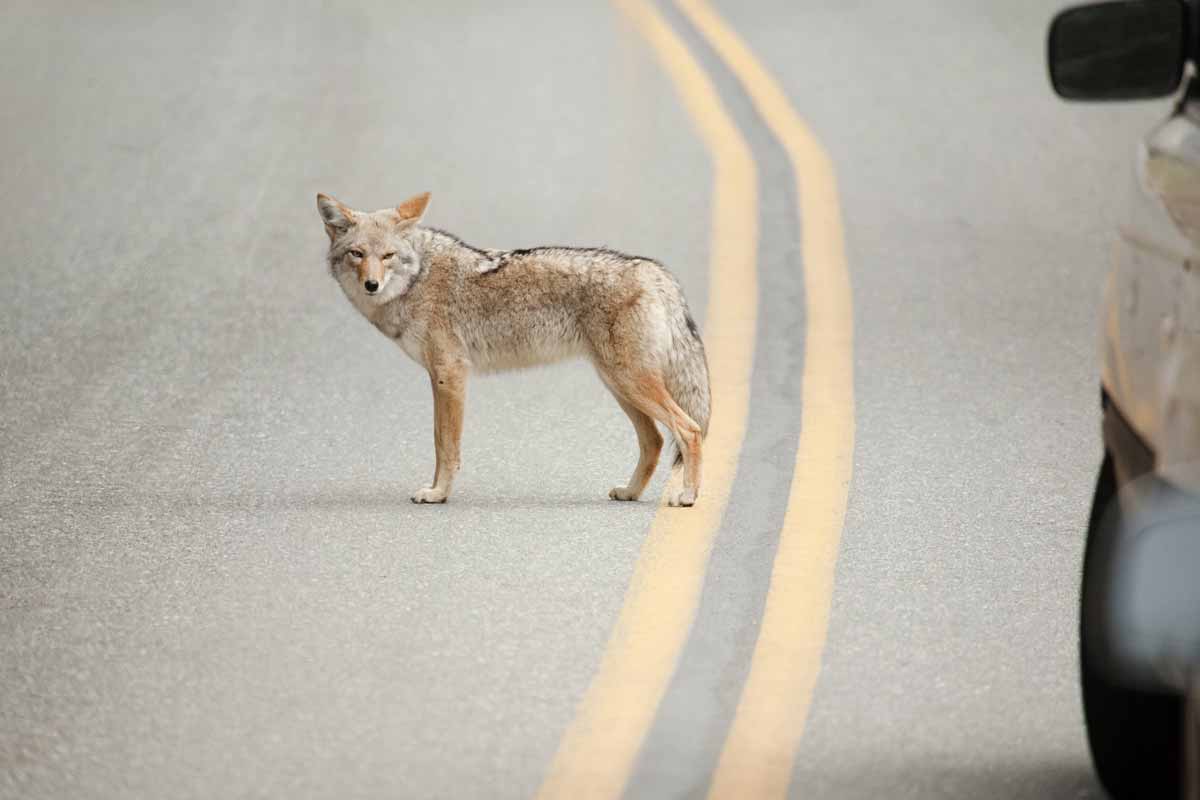
By luring them onto your property, you put yourself and your pets and neighbors at higher risk.
Why They’re There
Like most creatures, coyotes try to avoid humans even when their habitats have intersected with ours. However, coyotes are attracted to areas where there is a consistent source of food. For example, a coyote may be drawn to your backyard if there is pet food left outside or an open garbage can, compost heap, or ground-lying fruit. Once they have established your property as a source of food or water, they will continue to come back and may visit adjoining properties to look for food as well.
In rural areas, coyotes are commonly attracted to properties where there is livestock, poultry, and gardens that provide a constant source of food. Once they have killed prey on your property, they will continue coming back, and they are tough to get rid of.
If you are an individual who deliberately feeds wildlife, like raccoons, squirrels, etc., then you are creating an environment that makes you vulnerable to a host of nuisance pests, including coyotes. They are scavengers that prefer to find food rather than kill it, and it is important to take steps to eliminate easy food sources and dissuade them from getting too close to your home. By luring them onto your property, you put yourself and your pets and neighbors at higher risk. Once they learn to associate you with food, your chances of being attacked by a hungry or emboldened coyote increase as well, though such occurrences are rare.
Free roaming pets may be another attractant for coyotes, especially cats and small dogs that weigh less than 25 pounds. Keeping dogs on a leash and keeping your cats indoors, especially after dark, are best practices when it comes to keeping coyotes away.
Coyote Sounds
As with any canine, coyotes will bark, growl, snarl, and howl. Make sure you keep pets indoors to avoid any danger.
Coyote Tracks
As a canine, coyotes have four paws with four toes (claws) with the outer toes slightly larger. Their hind tracks are slightly smaller than the front. Their prints are oval shaped, approximately two and a half inches long by two inches wide. A coyotes gait will vary from walking and trotting to jogging and a full out run. They typical, and favored trot, will have the front and hind feet land close together with the hind feet landing slightly ahead of the front. This kind of gait often measures from 15 and 22 inches.
Coyote Poop
Coyote poop is often rope-like and spongy, two inches long and a half an inch in diameter, segmented and tapered. It usually contains hair and bone (although sometimes grass and berries), and is often gray colored.
Inspect
Should I Relocate This Animal?
Before taking steps to deal with a coyote in any way, it is important to contact your local game authority to see if you need a permit for trapping and removal. Coyotes are timid animals by nature and prefer to stay away from humans. In general, coexistence is possible and preferable. However, there are instances when a coyote’s habits are so severe that they pose a serious threat to your pets and children. This type of situation warrants removal. Having said that, coyotes are extremely difficult to trap, and professionals should only attempt this.
Relocation is illegal in some states where the law requires that a captured coyote has to be euthanized. In others, relocation may be an option even though studies have shown that coyote relocation is ineffective as they will travel up to 300 miles back to their capture site. Most relocated coyotes end up dying in the process of traveling back to their original location. Additionally, disease is a major concern when it comes to moving any kind of wildlife. When you move an infected animal, the disease moves with it and can infect a new population. And last, when you move a coyote, it just opens up an area for a new coyote to move in, so the cycle is not breaking through relocation.
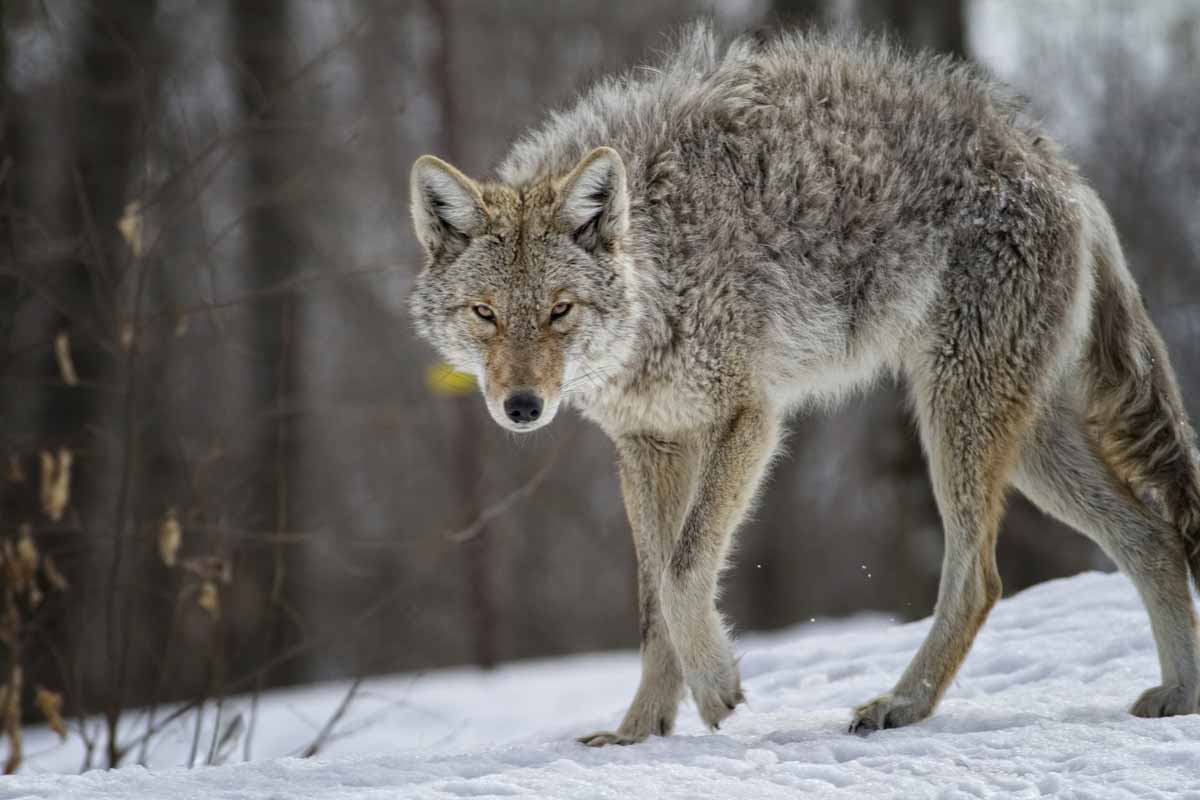
There are several humane and effective ways to handle a coyote presence on or near your property. The first step is understanding their behavior, habits, and why they are on your property in the first place so that you can formulate a plan for how to effectively get rid of them.
If you find that you cannot coexist with a coyote and you are unsuccessful in getting rid of it, it is important to contact a professional for help. Attempting to trap or handle a coyote yourself is unwise and unsafe. Again, coyote trapping and removal should be left to an experienced trapper who practices humane, legal, and environmentally-friendly techniques and has a deep understanding of the animal and the laws that pertain to its capture.
Gather The Tools You’ll Need
Since the relocation of a coyote is often illegal and may likely lead to euthanizing, it is important to be considerate as you decide how to handle an animal that has become a nuisance. In general, exclusion and prevention methods are humane and often effective ways to keep them away.
In the sections that follow, you will find multiple lists that include tools to help you exclude, prevent, and repel coyotes.
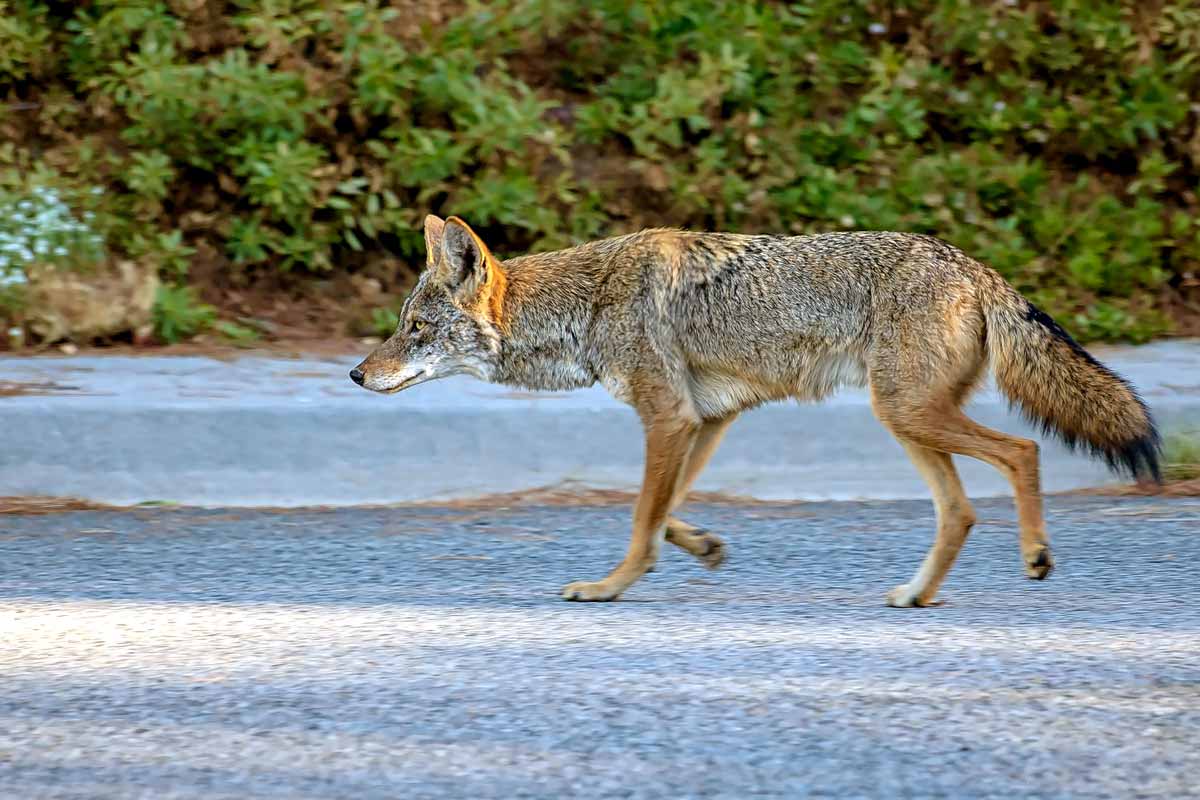
Treating Your Property For Coyotes
While exclusion methods that employ fences and barriers offer the most effective long-term protection, coyotes are intelligent and with enough determination (or hunger), will find a way to conquer most fences as well. The best approach is a comprehensive, multi-pronged effort that combines several methods.
Here are several humane and environmentally-friendly products on Amazon.com that may prove useful in your quest to get rid of coyotes once and for all:
DIY Treatments
One of the easiest ways to deter coyotes from interacting with you and your pets is to instill a healthy fear of humans. Coyotes have become so comfortable living close to humans that they are becoming desensitized to our presence and are more brazen in approaching our properties. The Humane Society offers a long list of coyote hazing ideas that make use of simple, readily available items that help to repel coyotes during negative encounters. If a coyote is not initiating a conflict, these hazing techniques should not be employed.
Be loud and large – yell, wave your arms, stomp your feet, and slowly approach the coyote until it retreats. Never run from a coyote! Stand your ground and loom large without backing off until the animal has completely retreated.
At-home repellents – Scare them away with a whistle, air horn, squirt gun, or even a stick thrown in their direction (the goal is to scare the animal without striking it).
At-home hazing – If a coyote approaches your property, spray it with your garden hose, bang pots and pans to frighten it, or try spraying it with a mixture of water and vinegar.
There are also deterrent concoctions that you can make out of household ingredients and spray on and around your property to deter coyotes:
Add one chopped onion, one chopped jalapeno pepper, and one tablespoon cayenne pepper to two quarts of boiling water. Cool and Strain before spraying.
Combine equal parts liquid dish soap and castor oil and add to one gallon of water.
Combine an entire bottle of Tabasco sauce and a bottle of distilled vinegar.
Coyote Problem?
In general, exclusion and prevention methods are humane and often effective ways to keep them away.
Risks Of Disease
Coyotes carry several diseases that may be dangerous to both you and your pet. Below is a list of the most common ones:
Rabies
Coyotes only carry Coyote-strain rabies in southern Texas, but coyotes can become infected with rabies from other species. In either case, it is a great danger to you and your pets and can be transmitted through a bite or a scratch.
Sarcoptic Mange
Coyotes are a host for this infectious and usually fatal form of mange. It is transmitted by a mite that burrows under the skin, causing an infection that leads to hair loss and low immunity in the animal. It can be transferred to pets and livestock if direct exposure to an infected animal occurs, making transmission rare.
Heartworm
Coyotes are carriers of canine heartworm, which poses a threat to domestic pets if coyotes live in the area.
Hydatid Disease
This is a tapeworm that is passable to both you and your pets. It is transmitted to humans, pets, and livestock through the feces of the infected animal, which contaminate food, water, or soil. It is fatal to humans.
Coyote Sounds
As with any canine, coyotes will bark, growl, snarl, and howl. Make sure you keep pets indoors to avoid any danger.
Coyote Tracks
As a canine, coyotes have four paws with four toes (claws) with the outer toes slightly larger. Their hind tracks are slightly smaller than the front. Their prints are oval shaped, approximately two and a half inches long by two inches wide. A coyotes gait will vary from walking and trotting to jogging and a full out run. They typical, and favored trot, will have the front and hind feet land close together with the hind feet landing slightly ahead of the front. This kind of gait often measures from 15 and 22 inches.
Coyote Poop
Coyote poop is often rope-like and spongy, two inches long and a half an inch in diameter, segmented and tapered. It usually contains hair and bone (although sometimes grass and berries), and is often gray colored.
In general, if a cat can get in your yard, so can a coyote.
Prevent
Prevention Methods
Coyotes are prevalent and pervasive across the U.S. where they thrive in suburban and urban habitats as well as rural environments. Because of their successful proliferation, even in urban neighboorhoods, we are susceptible to them encroaching on our property if the right environment exists. While coyotes prefer to keep their distance, they are scavengers who have come to rely somewhat on humans for food. Below is a list of steps you can take to dissuade and prevent a coyote from entering your property or returning.
Eliminate food sources
coyotes will keep coming back to your property if there are continuous, readily available food sources. You can prevent this by supervising small pets and making sure they are inside at night, keep pet food indoors, remove and clean around bird feeders, keep fallen fruit and seeds off the ground, trim bushes, and remove brush piles. Make sure that garbage cans are well sealed or moved indoors at night. You can also take it one step further and remove rodents from your yard, which will take away another common food source.
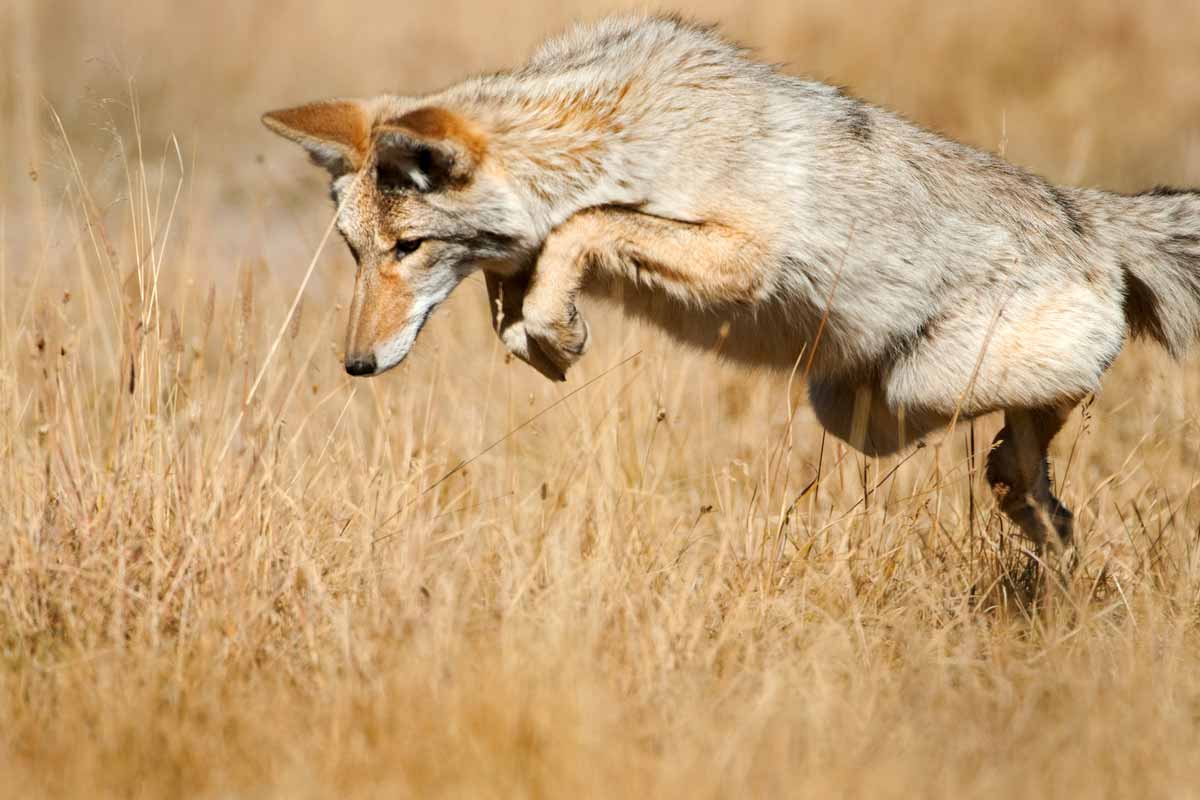
Fencing
this is the most effective, long-term way to keep coyotes off of your property once and for all. Putting up a fence is especially important if you have livestock, ground-dwelling birds, or small pets, as they will continue to attract coyotes. When installing a fence or barrier, make sure that it is at least six feet high and does not include any open spaces that they can use to climb. The fence must also extend at least eight inches underground to prevent them from digging underneath. In general, if a cat can get in your yard, so can a coyote. Use that as a guideline when installing fences and barriers. Consider installing rollers on top of the fence to prevent coyotes from climbing over the top.
Lights & Noise
coyotes are extremely evasive, nocturnal animals that will not approach an area where there is little cover or protection. Make sure your property has enough lights on it to keep the coyotes at bay. Install motion-sensor light and noise-making devices around the property so that they are activated when the animal passes in front of them.

Treating Your Property For Coyotes
While exclusion methods that employ fences and barriers offer the most effective long-term protection, coyotes are intelligent and with enough determination (or hunger), will find a way to conquer most fences as well. The best approach is a comprehensive, multi-pronged effort that combines several methods.
Here are several humane and environmentally-friendly products on Amazon.com that may prove useful in your quest to get rid of coyotes once and for all:
DIY Treatments
One of the easiest ways to deter coyotes from interacting with you and your pets is to instill a healthy fear of humans. Coyotes have become so comfortable living close to humans that they are becoming desensitized to our presence and are more brazen in approaching our properties. The Humane Society offers a long list of coyote hazing ideas that make use of simple, readily available items that help to repel coyotes during negative encounters. If a coyote is not initiating a conflict, these hazing techniques should not be employed.
Be loud and large – yell, wave your arms, stomp your feet, and slowly approach the coyote until it retreats. Never run from a coyote! Stand your ground and loom large without backing off until the animal has completely retreated.
At-home repellents – Scare them away with a whistle, air horn, squirt gun, or even a stick thrown in their direction (the goal is to scare the animal without striking it).
At-home hazing – If a coyote approaches your property, spray it with your garden hose, bang pots and pans to frighten it, or try spraying it with a mixture of water and vinegar.
There are also deterrent concoctions that you can make out of household ingredients and spray on and around your property to deter coyotes:
Add one chopped onion, one chopped jalapeno pepper, and one tablespoon cayenne pepper to two quarts of boiling water. Cool and Strain before spraying.
Combine equal parts liquid dish soap and castor oil and add to one gallon of water.
Combine an entire bottle of Tabasco sauce and a bottle of distilled vinegar.
Coyote Problem?
It is best to find naturally occurring repellents like wolf urine.
Odor repellents
there are very few odor repellents that are effective for coyotes. Wolf urine is a deterrent and can be applied to trash cans and other areas that attract the animals to your property. The downside is that they have to be reapplied often and may only be moderately effective. Other repellents include mothballs and ammonia-soaked rags, which are toxic and unsafe for wildlife, pets, and children. For those reasons, it is best to find naturally occurring repellents like wolf urine.
Get a large dog
When all else fails, large dogs are highly effective in keeping away a host of pests. Coyotes are roughly about the size of a medium-sized dog and will generally prey on animals that weigh less than 25 pounds. A large dog, like a German Shepherd, will usually suffice in scaring away a coyote. Once they know the threat exists, they will stay away from your property altogether.
Coyote Sounds
As with any canine, coyotes will bark, growl, snarl, and howl. Make sure you keep pets indoors to avoid any danger.
Coyote Tracks
As a canine, coyotes have four paws with four toes (claws) with the outer toes slightly larger. Their hind tracks are slightly smaller than the front. Their prints are oval shaped, approximately two and a half inches long by two inches wide. A coyotes gait will vary from walking and trotting to jogging and a full out run. They typical, and favored trot, will have the front and hind feet land close together with the hind feet landing slightly ahead of the front. This kind of gait often measures from 15 and 22 inches.
Coyote Poop
Coyote poop is often rope-like and spongy, two inches long and a half an inch in diameter, segmented and tapered. It usually contains hair and bone (although sometimes grass and berries), and is often gray colored.
When to Call a Professional
While it is reasonable to employ all and any of the methods mentioned above to handle coyotes yourself, there are quite a few scenarios in which you will want to contact a professional:
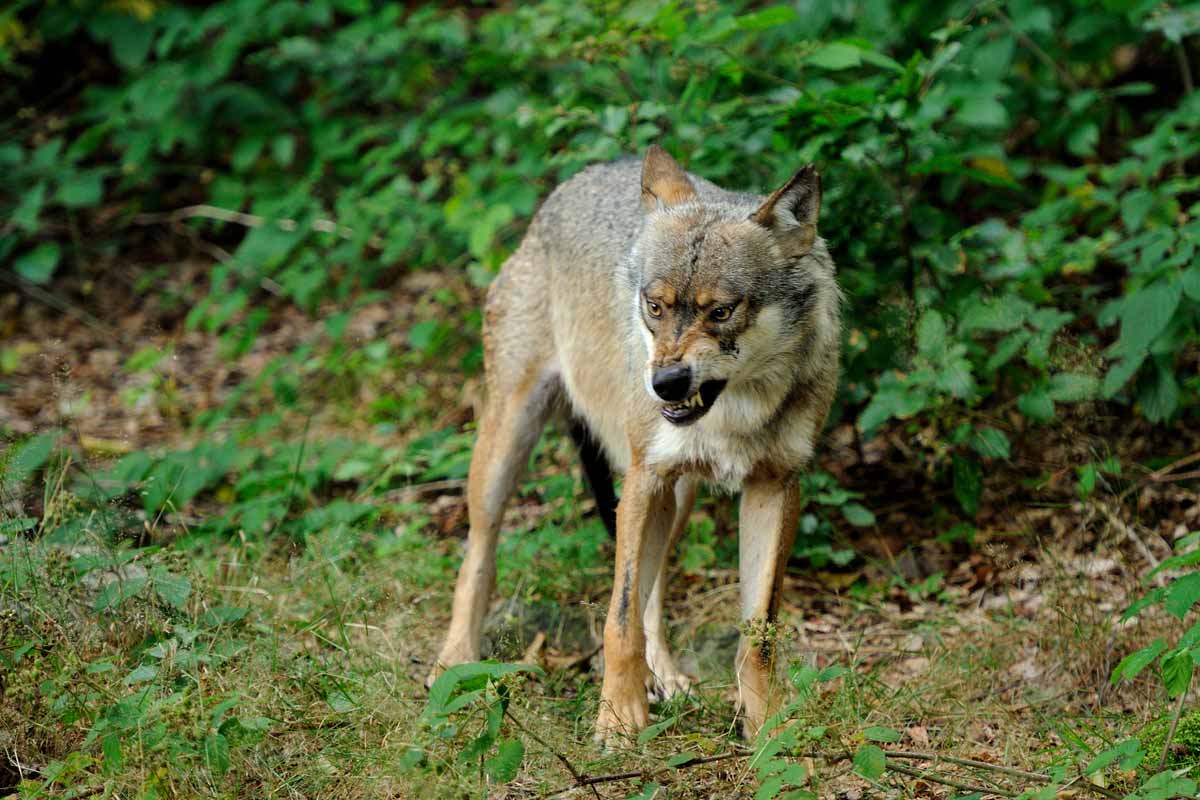
Aggressive behavior
if you observe a coyote on or near your property that is exhibiting unusually brazen or aggressive behavior, call 911 immediately and notify authorities. If you or your pet are attacked or bitten by a coyote, it is also important to call 911 immediately and seek medical attention as coyotes carry many diseases that humans and pets are susceptible to.
Intolerable habituation
If you have tried unsuccessfully to get rid of a coyote and you feel that trapping and removal are warranted, it is imperative that you call a professional trapper or animal control to assist you.
Sick animal
Coyotes carry a broad range of serious diseases, many of which can be passed to humans and pets. Mange and rabies both plague coyotes and can be dangerous. If you see a coyote that is noticeably sick, is very active during daylight hours or acts unusual in any way call animal control immediately.
Preying on livestock/crop damage
Coyotes will continue to prey on livestock, poultry, and other pets once they have killed one, so it is important to contact a professional who can help you devise a plan to rid your property of these animals. They will also ravage gardens and cause crop depredation. In both cases, it is imperative to call a professional for help to prevent further loss or damage.
Sources
http://www.wildlife-removal.com/coyote.html
https://urbancoyoteresearch.com/coyote-info/coyote-management-strategies
https://www.nationalgeographic.com/search?q=coyote
https://www.nwf.org/Magazines/National-Wildlife/2017/Dec-Jan/Animals/Coyotes
https://animalprosonline.com/nashville/coyote-removal/?gclid=CjwKCAiA9efgBRAYEiwAUT-jtMgQZcq3G_qVjw_pT_vYc-n0RyXyWr3LZWLoco-n_v1NPLddnZL8kxoCZGsQAvD_BwE
http://scientificwildlifemanagement.com/diseases-coyotes-can-carry-3/
https://www.ct.gov/deep/cwp/view.asp?a=2723&q=325992&depNav_GID=1655
https://www.livescience.com/27976-coyotes.html
https://www.who.int/news-room/fact-sheets/detail/echinococcosis
http://icwdm.org/handbook/carnivor/Coyotes.asp
https://cpw.state.co.us/Documents/WildlifeSpecies/LivingWithWildlife/Coyote-Exclusions-Deterrents-Repellents.pdf
http://www.coyotesmarts.org/coyotes101/
https://animalsake.com/types-of-coyotes
https://www.humanesociety.org/resources/coyote-hazing
http://wildliferemovalusa.com/coyote-how-to.html
Treating Your Property For Coyotes
While exclusion methods that employ fences and barriers offer the most effective long-term protection, coyotes are intelligent and with enough determination (or hunger), will find a way to conquer most fences as well. The best approach is a comprehensive, multi-pronged effort that combines several methods.
Here are several humane and environmentally-friendly products on Amazon.com that may prove useful in your quest to get rid of coyotes once and for all:
DIY Treatments
One of the easiest ways to deter coyotes from interacting with you and your pets is to instill a healthy fear of humans. Coyotes have become so comfortable living close to humans that they are becoming desensitized to our presence and are more brazen in approaching our properties. The Humane Society offers a long list of coyote hazing ideas that make use of simple, readily available items that help to repel coyotes during negative encounters. If a coyote is not initiating a conflict, these hazing techniques should not be employed.
Be loud and large – yell, wave your arms, stomp your feet, and slowly approach the coyote until it retreats. Never run from a coyote! Stand your ground and loom large without backing off until the animal has completely retreated.
At-home repellents – Scare them away with a whistle, air horn, squirt gun, or even a stick thrown in their direction (the goal is to scare the animal without striking it).
At-home hazing – If a coyote approaches your property, spray it with your garden hose, bang pots and pans to frighten it, or try spraying it with a mixture of water and vinegar.
There are also deterrent concoctions that you can make out of household ingredients and spray on and around your property to deter coyotes:
Add one chopped onion, one chopped jalapeno pepper, and one tablespoon cayenne pepper to two quarts of boiling water. Cool and Strain before spraying.
Combine equal parts liquid dish soap and castor oil and add to one gallon of water.
Combine an entire bottle of Tabasco sauce and a bottle of distilled vinegar.
Coyote Problem?
Sources
https://www.wildernesscollege.com/coyote-tracks.html
Coyote Sounds
As with any canine, coyotes will bark, growl, snarl, and howl. Make sure you keep pets indoors to avoid any danger.
Coyote Tracks
As a canine, coyotes have four paws with four toes (claws) with the outer toes slightly larger. Their hind tracks are slightly smaller than the front. Their prints are oval shaped, approximately two and a half inches long by two inches wide. A coyotes gait will vary from walking and trotting to jogging and a full out run. They typical, and favored trot, will have the front and hind feet land close together with the hind feet landing slightly ahead of the front. This kind of gait often measures from 15 and 22 inches.
Coyote Poop
Coyote poop is often rope-like and spongy, two inches long and a half an inch in diameter, segmented and tapered. It usually contains hair and bone (although sometimes grass and berries), and is often gray colored.


